My Mother’s Peasant Bread: The Best Easiest Bread You Will Ever Make
This post may contain affiliate links. Please read my disclosure policy.
This is the no-knead bread recipe my mother has been baking for 45 years. Start to finish, it can be ready in three hours. It bakes in well-buttered Pyrex bowls — no need to preheat a baking vessel for this recipe — and it emerges golden and crisp with a soft, tender crumb. 🍞🍞🍞🍞🍞
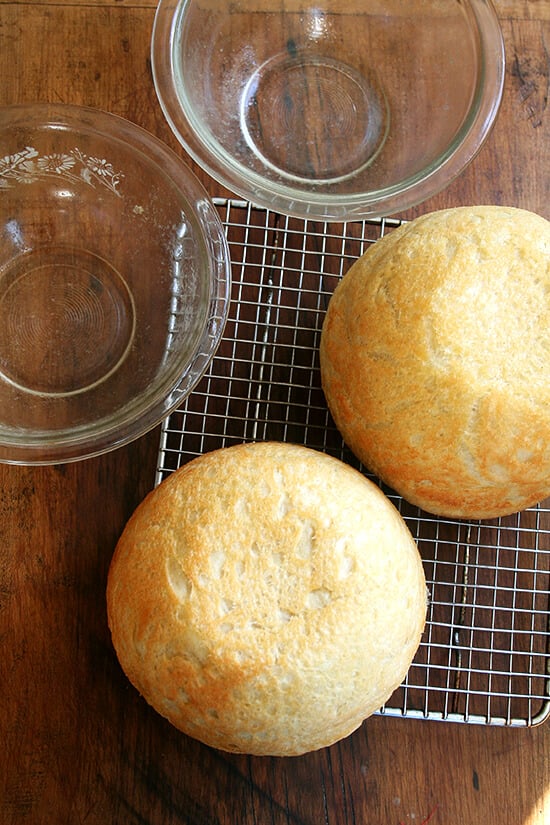
When I tell you that, if forced, I had to pick one and only one recipe to share with you that this — my mother’s peasant bread — would be it, I am serious. I would almost in fact be OK ending the blog after this very post, retiring altogether from the wonderful world of food blogging, resting assured that you all had this knowledge at hand. This bread might just change your life.
The reason I say this is simple. I whole-heartedly believe that if you know how to make bread you can throw one hell of a dinner party. And the reason for this is because people go insane over homemade bread. Not once have I served this bread to company without being asked, “Did you really make this?” And questioned: “You mean with a bread machine?” But always praised: “Is there anything more special than homemade bread?”
And upon tasting homemade bread, people act as if you’re some sort of culinary magician. I would even go so far as to say that with homemade bread on the table along with a few nice cheeses and a really good salad, the main course almost becomes superfluous. If you nail it, fantastic. If you don’t, you have more than enough treats to keep people happy all night long.
The Magic of the Peasant Bread
So what, you probably are wondering, makes this bread so special when there are so many wonderful bread recipes out there? Again, the answer is simple. For one, it’s a no-knead bread. I know, I know. There are two wildly popular no-knead bread recipes out there.
But unlike the others, this is a no-knead bread that can be started at 4:00pm and turned out onto the dinner table at 7:00pm. It bakes in well-buttered Pyrex bowls — there is no pre-heating of the baking vessels in this recipe — and it emerges golden and crisp without any steam pans or water spritzes. This is not artisan bread, nor is it trying to be. It is peasant bread, spongy and moist with a most-delectable buttery crust.
Genuinely, I would be proud to serve this bread at a dinner party attended by Jim Lahey, Mark Bittman, Peter Reinhart, Chad Robertson, Jeff Hertzberg and Zoe Francois. It is a bread I hope you will all give a go, too, and then proudly serve at your next dinner party to guests who might ask where you’ve stashed away your bread machine. And when this happens, I hope you will all just smile and say, “Don’t be silly. This is just a simple peasant bread. Easy as pie. I’ll show you how to make it some day.”
Peasant Bread Variations
Once you master the peasant bread, you can make any bread your heart desires — this simple no-knead bread recipe is the foundation of many of the other bread recipes on this site, namely this hugely popular overnight refrigerator focaccia and this simple homemade pizza dough. It’s even the inspiration behind this sourdough focaccia and this sourdough sandwich bread and this simple pita bread recipe.
The below post is organized as follows:
- How to Make Peasant Bread, Step by Step
- The Best Way to Store Bread
- Peasant Bread Dinner Rolls
- Peasant Bread Sandwich Bread
- How to Add Seeds and Nuts to Bread Dough
- How to Make Gluten-Free Peasant Bread
- How to Coat the Loaves in Seeds
- How to use Whole Wheat Flour
- How to Bake the Peasant Bread in a Dutch Oven
Many more variations on the peasant bread can be found in my cookbook, Bread Toast Crumbs:
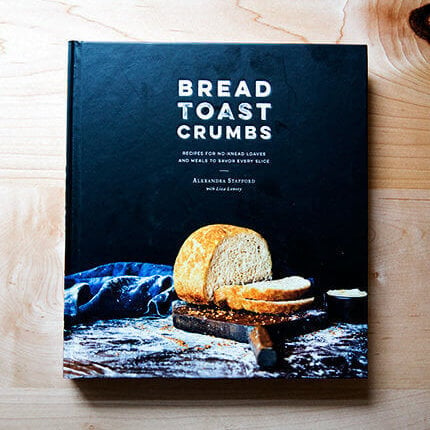
Bread Toast Crumbs
Love the peasant bread? There’s now a book filled with 40 simple bread recipes plus 70 recipes to use up every crumb of every loaf you bake.
How to Make Peasant Bread, Step by Step
First: You need yeast.
This is the yeast I buy exclusively: SAF Instant Yeast. Instant yeast can be whisked into the flour directly without any blooming or proofing. If you want to stick to active-dry yeast, there are instructions in the recipe notes on how to do so. Red Star yeast is great.

Whisk together flour, salt, sugar, and instant yeast. Add lukewarm water.
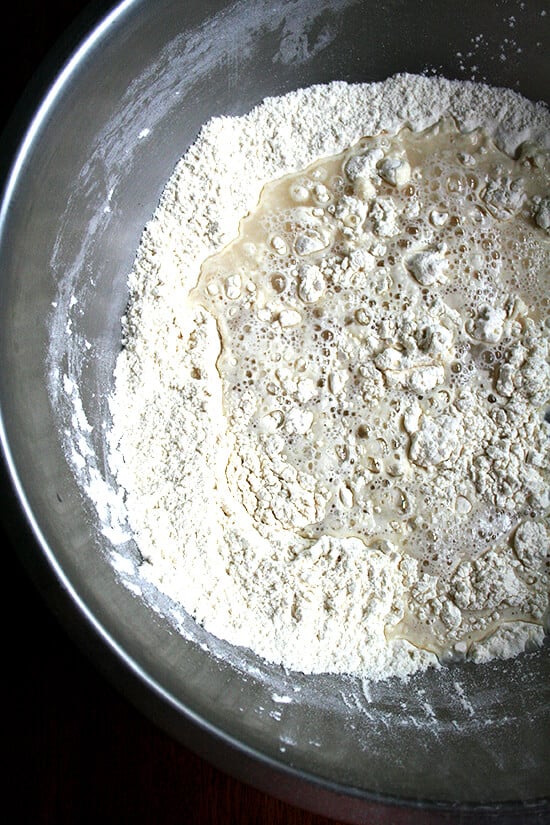
Mix until you have a sticky dough ball. Let it rise for 1.5 to 2 hours…
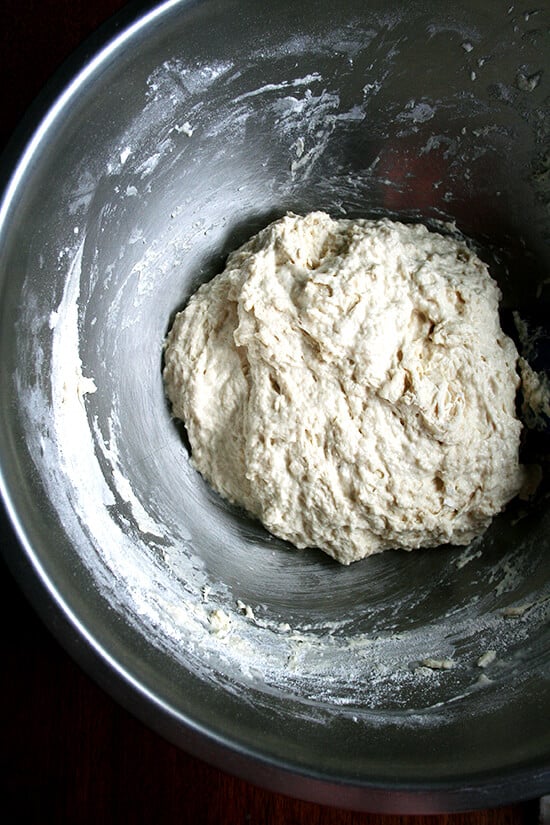
… or until it looks like this:

Punch down the dough using two forks.
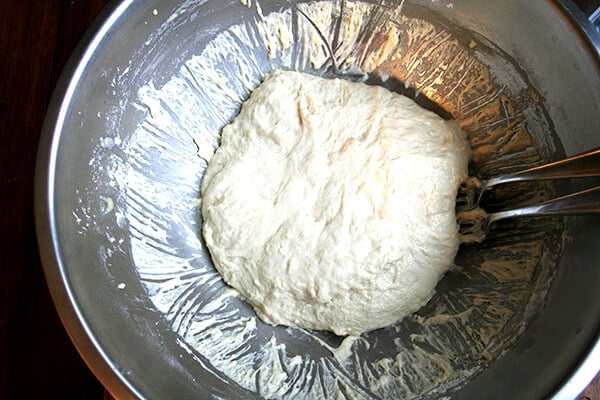
Then split the dough down the middle again using the two forks.

Because this is a very wet dough, it must be baked in an oven-proof bowl. I am partial to the Pyrex 1L 322 size, but any similarly sized oven-proof bowl will work.

Butter the bowls well; then transfer half of the dough to each prepared bow.

Let the dough rise again until it crowns the rim of the bowl, about 30 minutes.
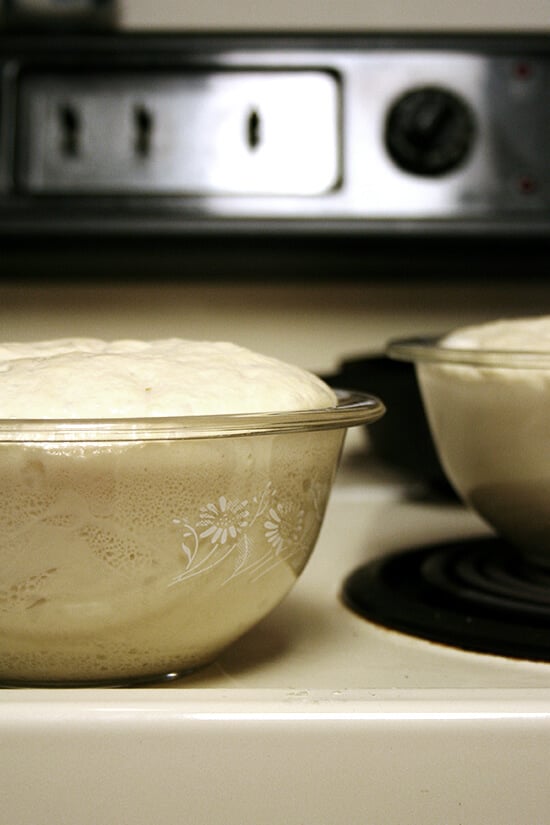
Transfer the bowls to the oven to bake:


This bread is irresistible when it’s freshly baked, but it also makes wonderful toast on subsequent mornings as well as the best grilled cheese. It’s also my favorite bread to use for these egg salad sandwiches and for this no-tuna “tuna” salad.

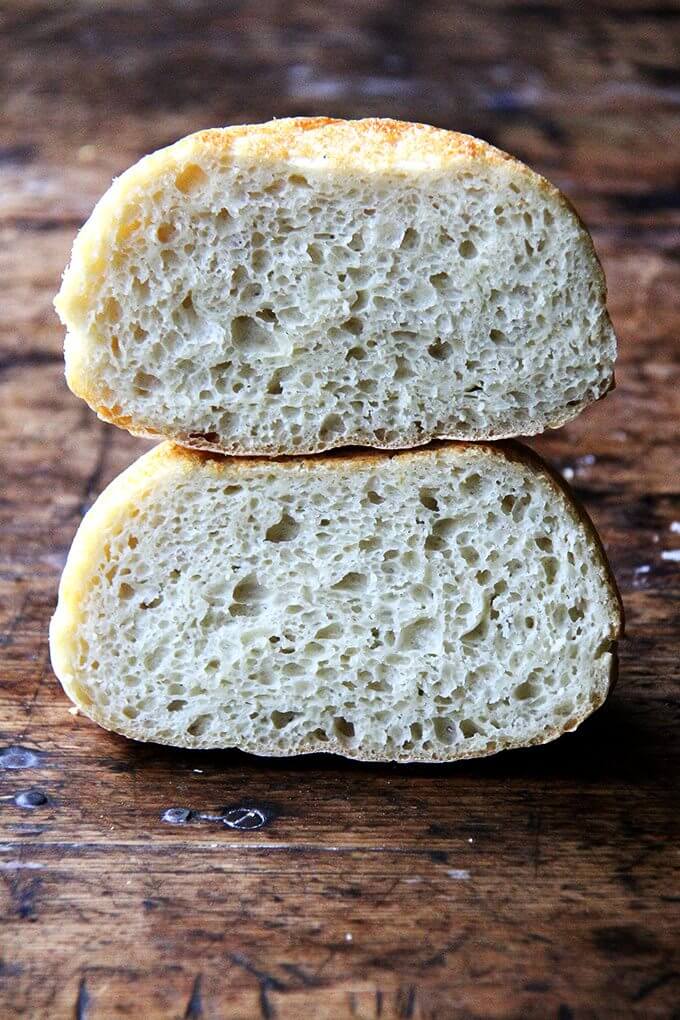
The Best Way to Store Bread
If you want to store the bread at room temperature for 3 to 4 days, I think the best method is in a ziplock bag. I’ve tried other eco-friendly options, but nothing seems to keep bread freshest — the crumb the softest — better than a ziplock bag. You can re-use the bags again and again.
If you intend to keep the bread for longer, I would freeze it. I often slice bread as soon as it cools completely, transfer the slices to a ziplock bag, then freeze. This way, I know the bread was frozen at its freshest.
A ziplock bag will not prevent the crust of bread from turning soft, which is why I suggest always reheating day-old bread. I use a toaster at breakfast for slices of bread, and I reheat half or quarter loaves in the oven at 350ºF for 15 to 20 minutes when serving for dinner.
Bread revives so beautifully in the oven or toaster.

No-Knead Dinner Rolls
To use the peasant bread dough to make rolls, simply divide the dough into smaller portions and place in a buttered muffin tin as in these No-Knead Thyme Dinner Rolls (pictured above). This recipe for no-knead buttermilk pull-apart rolls is also based on the peasant bread as are these brioche pull-apart rolls.
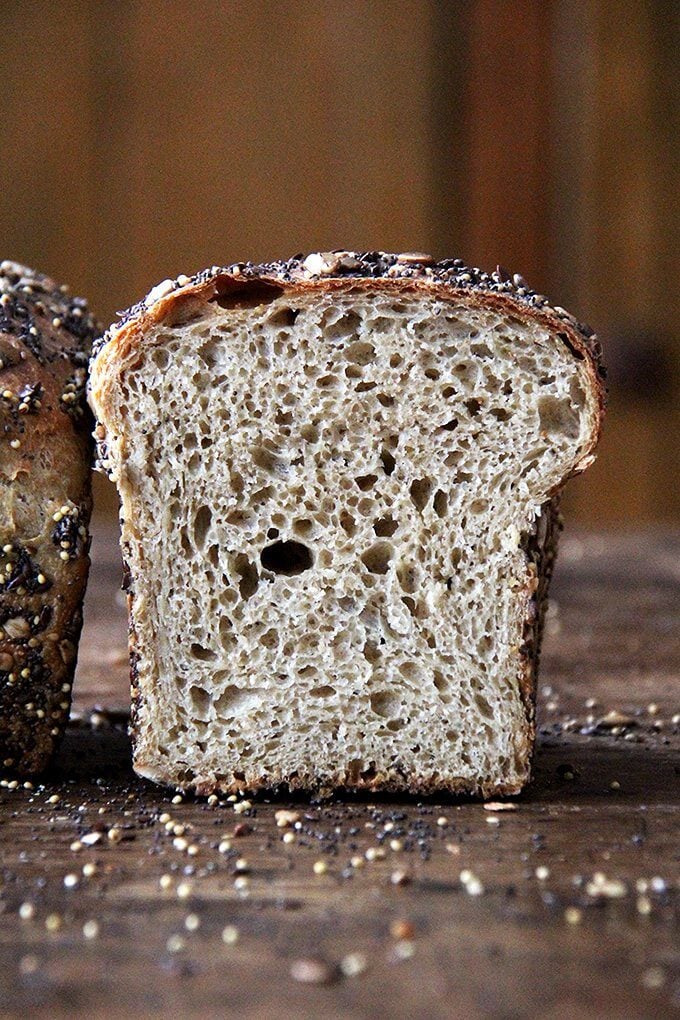
No-Knead Sandwich Bread
To make sandwich bread, multiply the recipe below by 1.5 and bake the bread in two buttered 8.5×4.5-inch loaf pans.
Made with half all-purpose flour and half King Arthur Sprouted Wheat Flour, these seed-coated sandwich loaves (pictured above) have a soft and light crumb. I really like KAF’s sprouted wheat flour, which is made from white whole wheat berries that, when sprouted, yield a creamy, sweet, milder-tasting flour. You can use 100% all-purpose or bread flour for an even lighter loaf or your favorite whole wheat flour in place of the sprouted wheat flour.
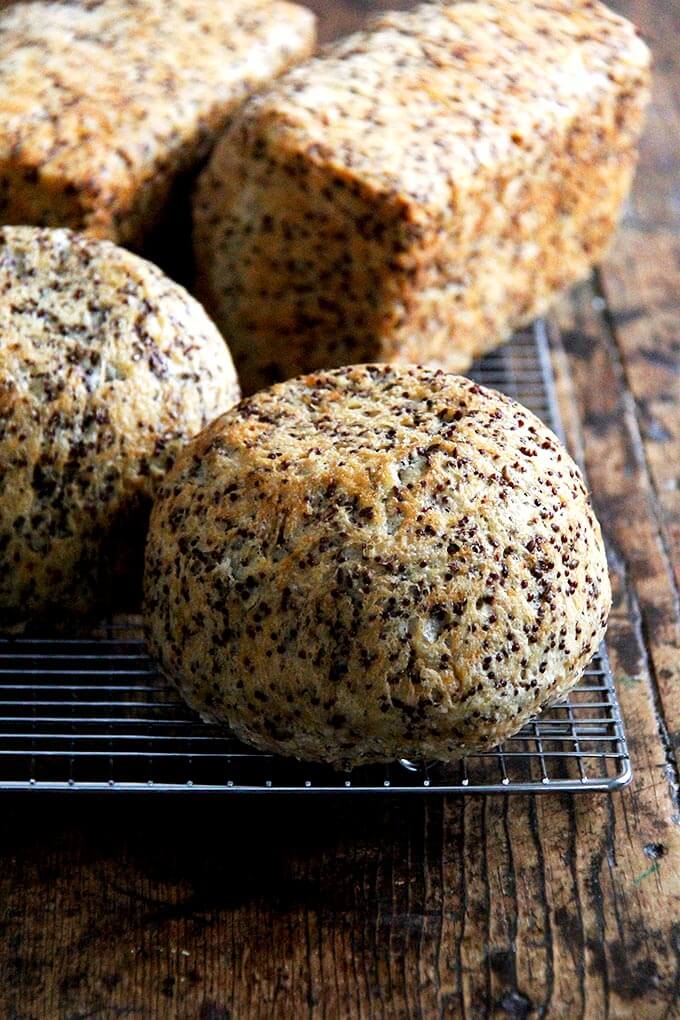
How to Add Nuts and Seeds to Bread Dough
To add seeds and nuts (or dried fruit and cheese), simply stir them into the dry ingredients. This recipe for Quinoa-and-Flax Toasting Bread will offer guidance on how much to add.

How to Make a Gluten-Free Peasant Bread
Making gluten-free peasant bread (pictured above) unfortunately isn’t as simple as swapping in gluten-free flour for the wheat flour. But the process and recipe is still super simple — in fact, because there’s only one rise, many people find the gluten-free peasant bread to be even simpler than the original. Find the recipe here: Gluten-Free Peasant Bread

How to Coat the Loaves in Seeds
To coat the peasant bread in seeds, as pictured above, simply coat the bowls with everything bagel seasoning or with dukkah or sesame seeds or whatever seed mix you wish. The seed-coated loaves look so beautiful, and it’s amazing how much the flavor of the coating permeates the loaves. Find the recipe here: Everything Bagel Seasoning Peasant Bread

How to Use Whole Wheat Flour
To use whole wheat flour in the peasant bread, simply replace as much as 50% of the all-purpose flour with your favorite whole wheat flour: I like KAF’s sprouted wheat flour, and I’ve been loving the Cairnsprings Mill Trailblazer stone-milled flour. With the Trailblazer, I can use up to 75% of it in the peasant bread, and it yields a beautiful, chewy texture as well as a lovely flavor and aroma.
When using whole wheat flour, you may have to use more or less water — there is no rule as to how much more or less, and it will take some trial and error to get right because all flours absorb water differently. When I use KAF sprouted wheat flour, for example, I don’t change the water amount at all. When I use the Trailblazer flour, on the other hand, I reduce the water by at least 50 grams.
If you’d like to learn more about whole wheat flour and stone-milled flours, read this: Easy Sourdough Bread (Whole Wheat-ish)
How to Bake the Peasant Bread in a Dutch Oven
If you’re looking for more of a crackling crusted boule (characteristic of a loaf of sourdough bread) as opposed to the buttery crispness of the peasant bread, you can bake the peasant bread dough in a preheated Dutch oven.
There are detailed instructions below the recipe in the notes section, but one thing to keep in mind before you begin is dough hydration. The peasant bread is a very high hydration dough, meaning there is a lot of water relative to flour. Because baking the peasant bread in a Dutch oven will require some handling of the dough — to shape it into a round and to create some tension — you may want to reduce the water from the start. Consider holding back 20-30 grams of water to make the process more manageable for you.
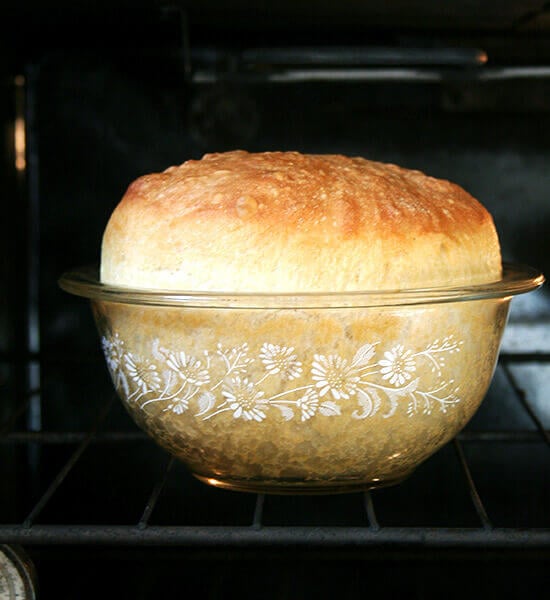
My Mother’s Peasant Bread: The Best Easiest Bread You Will Ever Make
- Total Time: 2 hours 27 minutes
- Yield: 2 loaves
Description
Notes:
The bread:
This is a sticky, no-knead dough, so, some sort of baking vessel, such as pyrex bowls (you need two 1-qt bowls) or ramekins for mini loaves is required to bake this bread. See notes below the recipe for sources. You can use a bowl that is about 2 qt or 2 L in size to bake off the whole batch of dough (versus splitting the dough in half) but do not use this size for baking half of the dough — it is too big.
Peasant Bread Fans! There is now a book: Bread Toast Crumbs, a loaf-to-crumb bread baking book, filled with tips and tricks and answers to the many questions that have been asked over the years. In the book you will find 40 variations of the master peasant bread recipe + 70 recipes for using up the many loaves you will bake. Learn more about the book here or buy it here.
Ingredients
- 4 cups (512 g) unbleached all-purpose or bread flour
- 2 teaspoons (10 g) kosher salt
- 2 cups (454 g) lukewarm water (made by mixing 1.5 cups cold water with 0.5 cup boiling water)
- 2 teaspoons (8 g) sugar
- 2 teaspoons (8 g) instant yeast, I love SAF Instant Yeast, see notes below
- room temperature butter, about 2 tablespoons
Instructions
- Mixing the dough: In a large mixing bowl, whisk together the flour, salt, sugar, and instant yeast (I love SAF Instant Yeast). Add the water. Mix until the flour is absorbed. (If you are using active dry yeast, see notes below.)
- Let it rise. Cover bowl with a tea towel or plastic wrap and set aside in a warm spot to rise for at least an hour. (In the winter or if you are letting the bread rise in a cool place, it might take as long as two hours to rise.) This is how to create a slightly warm spot for your bread to rise in: Turn the oven on at any temperature (350ºF or so) for one minute, then turn it off. Note: Do not allow the oven to get up to 300ºF, for example, and then heat at that setting for 1 minute — this will be too hot. Just let the oven preheat for a total of 1 minute — it likely won’t get above 100ºF. The goal is to just create a slightly warm environment for the bread.
- Preheat the oven to 425ºF. Grease two 1-qt or 1.5-qt oven-safe bowls (see notes below) with about a tablespoon of butter each. Using two forks, punch down your dough, scraping it from the sides of the bowl, which it will be clinging to. As you scrape it down try to pull the dough toward the center (see video below for guidance). You want to loosen the dough entirely from the sides of the bowl, and you want to make sure you’ve punched it down. Then, take your two forks and divide the dough into two equal portions — eye the center of the mass of dough, and starting from the center and working out, pull the dough apart with the two forks. Then scoop up each half and place into your prepared bowls. This part can be a little messy — the dough is very wet and will slip all over the place. Using small forks or forks with short tines makes this easier — my small salad forks work best; my dinner forks make it harder. It’s best to scoop it up fast and plop it in the bowl in one fell swoop. Some people like to use flexible, plastic dough scrapers for this step.
- Let the dough rise again for about 20 to 30 minutes on the countertop near the oven (or near a warm spot) or until it has risen to just below or above (depending on what size bowl you are using) the top of the bowls. (Note: Do not do the warm-oven trick for the second rise, and do not cover your bowls for the second rise. Simply set your bowls on top of your oven, so that they are in a warm spot. Twenty minutes in this spot usually is enough for my loaves.)
- Bake it. Bake for 15 minutes. Reduce the heat to 375º and bake for 15 to 17 minutes longer. Remove from the oven and turn the loaves onto cooling racks. If you’ve greased the bowls well, the loaves should fall right out onto the cooling racks. If the loaves look a little pale and soft when you’ve turned them out onto your cooling racks, place the loaves into the oven (outside of their bowls) and let them bake for about 5 minutes longer. Remove from oven and let cool for 10 minutes before cutting.
Notes
- The bowls: The cheapest, most widely available 1-qt bowl is the Pyrex 322. Update: These bowls are becoming harder to find and more expensive. As a result, I’m suggesting this cheaper option: the Pyrex 3-piece set. You can split the dough in half as always (see recipe) and bake half in the 1-quart bowl and half in the 1.5 quart bowl. The loaves will not be the same shape, but they will be delicious nonetheless.
- Yeast: I buy SAF Instant Yeast in bulk from Amazon I store it in my fridge or freezer, and it lasts forever. If you are using the packets of yeast (the kind that come in the 3-fold packets), just go ahead and use a whole packet — It’s 2.25 teaspoons. I have made the bread with active dry, rapid rise, and instant yeast, and all varieties work. The beauty of instant yeast is that there is no need to “proof” it — you can add the yeast directly to the flour. I never use active-dry yeast anymore.
- If you have active-dry yeast on hand and want to use it, here’s how: In a small mixing bowl, dissolve the sugar into the water. Sprinkle the yeast over top. There is no need to stir it up. Let it stand for about 10 to 15 minutes or until the mixture is foamy and/or bubbling just a bit — this step will ensure that the yeast is active. Meanwhile, in a large bowl, whisk together the flour and salt. When the yeast-water-sugar mixture is foamy, stir it up, and add it to the flour bowl. Mix until the flour is absorbed.
- Troubleshooting: You can find step-by-step video instruction here.
- Several commenters have had trouble with the second rise, and this seems to be caused by the shape of the bowl they are letting the dough rise in the second time around. Two hours for the second rise is too long. If you don’t have a 1-qt bowl, bake 3/4 of the dough in a loaf pan and bake the rest off in muffin tins or a popover pan. The second rise should take no more than 30 minutes.
- Also, you can use as many as 3 cups of whole wheat flour, but the texture changes considerably. I suggest trying with all all-purpose or bread flour to start and once you get the hang of it, start trying various combinations of whole wheat flour and/or other flours.
- The single most important step you can take to make this bread truly foolproof is to invest in a digital scale. This one costs under $10. If you are not measuring by weight, do this: scoop flour into the measuring cup using a separate spoon or measuring cup; level off with a knife. The flour should be below the rim of the measuring cup.
- Here’s a printable version of this recipes that’s less wordy: Peasant Bread Recipe, Simplified
- How to Bake the Peasant Bread in a Dutch Oven: Preheat a Dutch Oven for 45 minutes at 450ºF. Dust a clean work surface with flour. After the first rise, turn the dough out onto the floured surface and shape it into a ball: I like to fold it envelope style from top to bottom, then side to side; then I flip it over and use the pinkie edges of my hands to pinch the dough underneath and create some tension. Transfer the dough to a sheet of parchment paper. Let rest for 20 minutes. If you feel your dough is spreading too much you can lift up the sheet of parchment paper, dough and all, and place it in a bowl of a similar size. After the 20 minutes, transfer the dough, parchment paper and all to the Dutch oven. Carefully cover it. Bake 30 minutes. Uncover. Bake 15 minutes more.
- To bake the peasant bread in a loaf pan: If you are using an 8.5×4.5-inch loaf pan or a 9×5-inch loaf pan, you can bake 3/4 of the dough in it; bake off the rest of the dough in ramekins or other small vessels … the mini loaves are so cute. You can also make 1.5x the recipe, and bake the bread in 2 loaf pans. If you have a large loaf pan, such as a 10×6-inch loaf pan, you can bake off the entire batch of dough in it. For loaf pans, bake at 375ºF for 45 minutes.
- How to Bake at Hight Altitude:
- First try the original recipe as written (preferably with a scale). You may not need to make any adjustments. One commenter, who lives at 9200 ft finds the original recipe to work just fine as is.
- If the original recipe doesn’t work, try adding a little bit more water because it rises fast and it is so dry: about a quarter cup for every 512 g of flour.
- Try decreasing the yeast to 1.5 teaspoons.
- If your dough is especially gooey, try decreasing the water by 1/4 cup. But, if you aren’t using a scale, my first suggestion would be to buy a scale and weigh the flour, and make the bread once as directed with the 2 cups water and 512 grams flour, etc.
- Punch the dough down twice before transferring it to the buttered Pyrex bowls. In other words, let it rise for 1-1.5 hours, punch it down, let it rise again for about an hour, punch it down, then transfer it to the buttered bowls.
- Variations:
- #1. Cornmeal. Substitute 1 cup of the flour with 1 cup of cornmeal. Proceed with the recipe as directed.
- #2. Faux focaccia. Instead of spreading butter in two Pyrex bowls in preparation for baking, butter one 9×9-inch glass baking dish and one Pyrex bowl or just butter one large 9×13-inch Pyrex baking dish. If using two vessels, divide the dough in half and place each half in prepared baking pan. If using only one large baking dish, place all of the dough in the dish. Drizzle dough with 1 tablespoon of olive oil (if using the small square pan) and 2 tablespoons of olive oil (if using the large one). Using your fingers, gently spread the dough out so that it fits the shape of the pan. Use your fingers to create dimples in the surface of the dough. Sprinkle surface with chopped rosemary and sea salt. Let rise for 20 to 30 minutes. Bake for 15 minutes at 425ºF and 17 minutes (or longer) at 375ºF. Remove from pan and let cool on cooling rack.
- #3. Thyme Dinner Rolls
- #4 Gluten-free
- #5. Everything Bagel Seasoning Bread. Simply coat the buttered bowls with Everything Bagel Seasoning. Watch a how-to on Instagram Stories here.
- #6: Whole Wheat Peasant Bread. Use as much as 50% whole wheat flour. I like King Arthur Flour’s white whole wheat flour (see this post) or sprouted wheat flour (see this post).
- Prep Time: 5 minutes
- Cook Time: 32 minutes
- Category: Bread
- Method: Baked
- Cuisine: American
This post may contain affiliate links. Please read my disclosure policy.

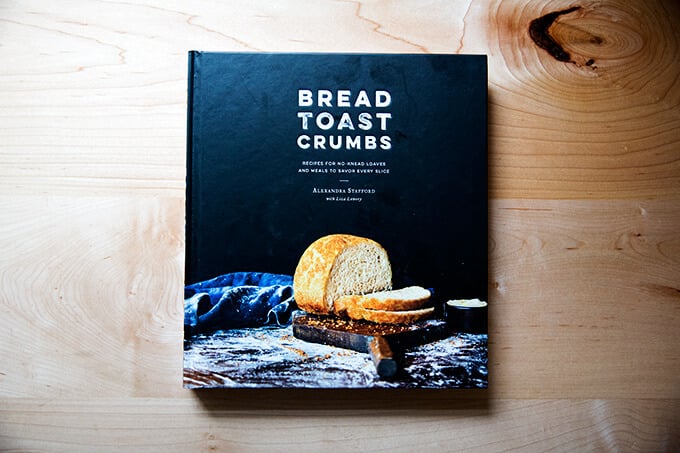










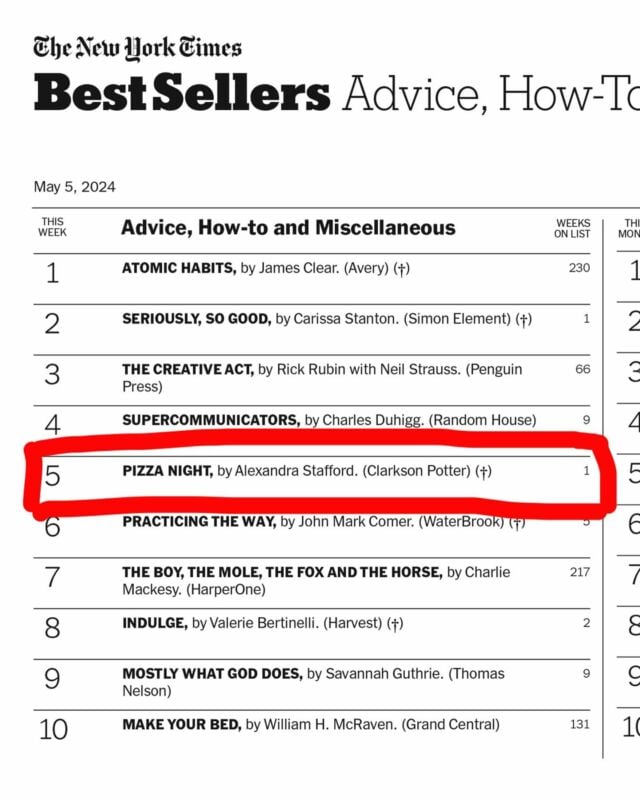



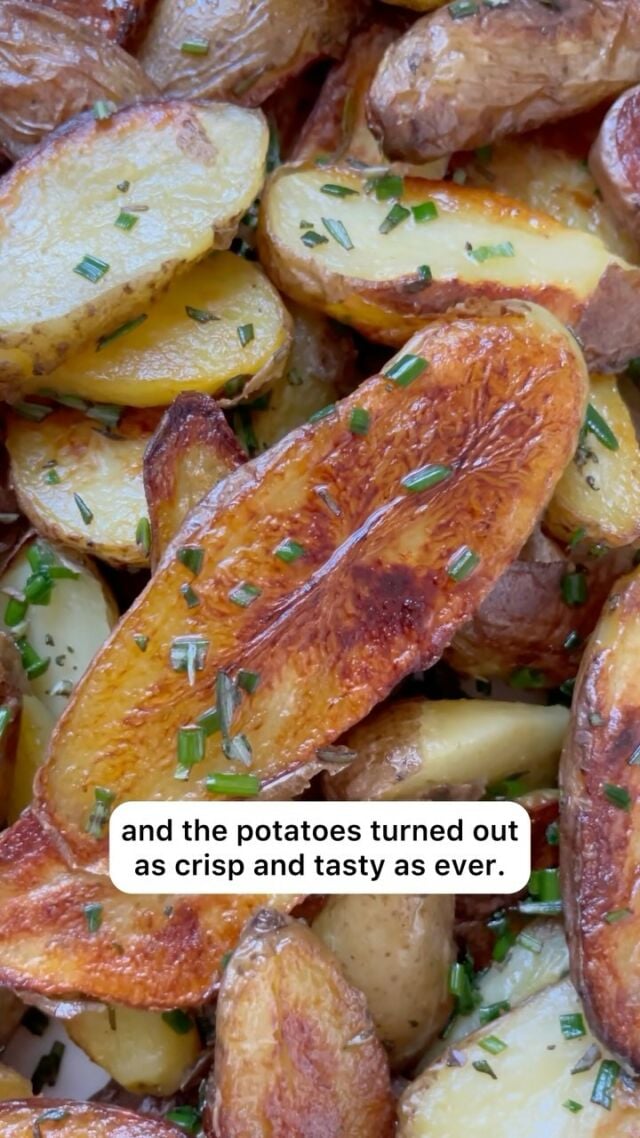



6,424 Comments on “My Mother’s Peasant Bread: The Best Easiest Bread You Will Ever Make”
Hi, I know this may be a obvious question but I have to ask haha. When you lower them temp from 425° to 375° so I have to remove the bowls from the oven or countdown the 15-17 minutes from when I manually drop the temp? Or do I wait u til the oven is 375° to count? I’m stumped hopefully someone can answer. Thank you
Hi! No need to remove the bowls — simply lower the oven temp to 375F after the first 15 minutes.
Looks like a great recipe! Instead of dividing the loaves could I bake it in one 2 1/2 quart Pyrex bowl? Is there a advantage to dividing it?
No advantage to dividing apart from getting two loaves … one to freeze, one to gift, etc. So, go for it: use your 2.5 qt bowl. I would add 10 minutes to the baking time. Or do something like: 15 minutes at 425ºF, 30 minutes at 375ºF.
This was so good! I used 50% wheat and AP flours. The rising the second time wasn’t fully happening, but maybe got close. Still turned out great, even with my impatience. I will probably make another loaf on Monday.
Great to hear, Laura! It’s hard to be patient sometimes… I get it 🙂
I am novice bread maker
Can I use fleischmanns rapid rise instant yeast?
Or I have red star active dry yeast
You can use either of those! With the instant yeast, you can stir it right into the flour. With the red star, follow the instructions in the recipe for using active dry yeast. Good luck!
Truly perfect bread – so quick and easy and DELICIOUS ‼️
Great to hear this, Sandra! Thanks for writing 🍞🍞🍞🍞🍞
This was really easy! Thank you for sharing. Are you going to have any more kits available?
Would you let me know if you do? 🙂
Thank you,
Mandy
So nice to hear this, Mandy 🙂 🙂 🙂
And yes re kits … hopefully very soon! I will email you when I am back in stock. Thank you!
I did use a scale and weighed everything exactly, my dough was too sticky, I will reduce the water I guess. The biggest problem was the second rise, after one hour it still was not to the top of the bowls(yes I used the suggested size Pyrex bowls), my kitchen is rather cold at this time. It did bake up rather nicely and tasted good, but it did not have a large enough crumb, it seemed too dense. I won’t give up because these seem perfect size for us. I am trying to find a warmer place for the second rise, you seem to discourage a warm oven, mine gets slightly warmer with the light on. Any suggestions would really be appreciated.
thanks
If your oven with the light on only gets slightly warm, give it a shot!
What type of flour are you using? Brand and variety?
I heated up a wheat pack in the microwave for a couple of minutes and sat the bowl on top and covered it with a towel, rose absolutely perfectly 👌
Great to hear, Lorena!
What I used to do, because my oven and kitchen counters were on an outside, not inside wall (so it got super cold to try and rise anything sometimes) was to put a bowl of hot water in the oven along with the dough to rise. I never got technical with the temps, but once it was super hot out of the tap, I’d fill a large wide bowl, put it in the oven for maybe 10-30 mins. To kind of prep the inside a bit, then put the dough in the oven. Sometimes I could take the water out, sometimes I had to keep it. Different ratios of water in recipes and then what your actual temp is hard to make it exact in times. But I find having a wet heat instead of a dry heat always worked best for cold problems.
Hi Ali,
I started making your bread just after Christmas and have been making it weekly ever since. I made four loaves early in the morning on Saturday during the snowstorm and sent two to my neighbors who were so excited to have it for their big breakfast!
I make it in a dutch oven because I love the beautiful browned crust you get from baking it that way. I would like to bake it in my cast iron loaf pan. I’ve read your variations, and many of the comments regarding loaf pans but did not see anything specifically about a cast iron loaf pan. What adjustments should I make to oven temperature and time, etc.? Also, should I cover it? Thank you!
Hi! So nice to hear all of this. I don’t think you need to make any changes for the cast iron loaf pan: butter it very well; bake it at 375F for 45 minutes. What size is your cast iron loaf pan?
It is 8.5 x 4.5. Thank you!
OK, so you won’t be able to fit all of the dough in that one pan. You can either make 3/4 of the recipe, which will give you enough for 1 loaf pan, or make 1.5x the recipe, which will give you enough dough for 2 loaf pans.
Great recipe
Great recipe, easy to make for a complete novice. Makes lovely toast too!
It seemed too easy to be good but it’s not just good, it’s great! Crusty exterior with supple, soft crumb. Perfect for sandwich (albeit smaller than commercial bread) and toast. Reminds me of the cottage bakers in the countryside of England. Thank you for sharing this recipe, Alexandra. Easy to make and even better to devour, which is why my family gobbles up a few loaves a week!
So nice to hear this, Erica! Thank you so much for writing. Great to hear the family gobbles it up, too… the best feeling 🙂 🙂 🙂
My loaves to did rise any further in the oven. Im guessing they’re supposed to rise further in the oven?
Hi Stacey! Yes, the loaves should rise slightly more in the oven. What size bowls are you using? And did the dough crown the rim of the bowls before you placed the bowls in the oven?
Love the ease of this bread. Making a cookbook for my granddaughter and this is the first recipe I’m adding. She loves it and can learn to make it herself. I am going to have her make a batch and put it in the Wiltons extra long loaf instead of the 2 bowls which we have done dozens of times.
Thank You Alexandra.
So wonderful to hear this, Shirley! I love that this is a bread recipe that is doable for kids. My 11-year old loves making it! Thanks for writing!
Made this bread yesterday, so easy to make and so delicious! Mine didn’t look as pretty, but I’ll keep practicing.
I will definitely be making this bread again.
Thank you for all your delicious recipes,
Judy
Great to hear, Judy! Two tips: be generous with the softened butter — it creates that beautifully golden crust. And if you found your loaves to be not as brown, you can try baking the bread at 425ºF for a longer period of time … even the entire amount.
One last tip, turn the loaves out so that the exposed side (the side not touching the glass bowl) is the bottom and the bowl side is the top.
Good luck on your next go!
Absolutely delicious and so easy ❤️
Great to hear, Catherine!
Hi! I am so excited to try this. My bread is rising in the oven right now! I used red star and had to activate first with instructions on the packet,. In your description of using regular yeast you said mix flour and salt, are we still adding the 2 tsp of sugar as well if we aren’t doing instant yeast? Just wanted to clarify! Thank you!
Hi Chelsea! If you use active dry yeast, you can sprinkle it over the lukewarm water with the sugar; let it stand for 15-20 minutes or until foamy; then proceed with the recipe. So yes, there are 2 teaspoons of sugar in the recipe regardless if you are using active dry or instant yeast. Hope that helps and I hope your bread turned out well!
I just made the recipe, my bread came out hard as a rock. What did I do wrong? Are we supposed to preheat the oven or not? I saw the TikTok video and baking instructions were different. I did 425 (not preheated for 15mins, then reduced to 325 for 17, top didn’t have color so I added 10 more minutes. I really want to master this recipe
Hi Yanet,
Yes, you preheat the oven, and once it gets to 425ºF, you place the bowls in the oven. If your oven runs cool, you can keep the temperature at 425ºF for the entire time. It sounds as though you might want to try that but if you start with a hot oven, you’ll definitely get better browning.
What type of flour are you using? Are you using a scale?
I have made this bread a few times when I didn’t want to do an overnight rise. Until recently I don’t usually bake bread but this recipe is very good very easy and I really appreciate it thank you. It’s last time I made it it it was wetter and it was harder to separate and get all the DOUGH out of the Bowl but it still was fine. For the 1st rising it rose more than it usually does And the DOUGH stuck to the Plastic wrap I didn’t use lose that much dough,so it fine.
Hi Wendy! Great to hear. Sometimes the change in seasons affects the consistency of the dough. Are you using a scale to measure the flour and water?
I made this bread for the first time today. I think its the first time I’ve made bread, period!! It turned out absolutely wonderful. I made one plain, and the other with Everything but the Bagel seasoning sprinkled on top. Since I don’t have 1 qt Pyrex bowls, I used a couple of 1 qt Pyrex baking dishes…perfect! I want to try the faux focaccia next. Thank you for sharing and inspiring me to try something new!
Wonderful to hear this, Jaime! Thanks so much for writing and sharing your notes. So glad you were able to make the recipe work with what you had on hand.
I tried your peasant bread recipe but I cut the recipe in half because I only wanted one small loaf for myself. So instead of 512 g or flour, I used 256 g. I used one tsp of salt, sugar and yeast and 1 cup of warm water and my dough came out more like batter than in the video. I couldn’t transfer it to the bowl with forks. It just slips through the forks. What did I do wrong? Can the amounts not be cut straight in half? Should I have left the yeast amount at 2 tsp? I wound up with a flatter loaf that didn’t spring much past the rim of the bowl. My SAF instant yeast did have a good rise 2 hours after first mixing so the yeast is good.
Hi Gary, Yes, the recipe can be halved with success. Since you have a scale, next time, I would weigh the water, too: use 227 grams water. I think it’s simply a matter of using too much water relative to the flour. Do you live in a humid environment? What type of flour are you using?
My family loves this recipe. I am making it for the second time!
Great to hear, Jessica! Thanks for writing 🙂
I noticed that the master recipe in the book says to use 2.25 teaspoons of yeast while the online version says 2.0 teaspoons. Which is preferred? Either way the bread is yummy!
Hi Mimi! The truth is you can use either. Most people use packets of yeast, in which case I suggest using the whole packet, which is 2.25 teaspoons. If you are buying bulk yeast like SAF, then using 2 teaspoons is just fine.
Thanks!
I am not sure what is wrong with my bread, I have tried the bowls and the loaf. Both times the dough and bread has a bitter taste. It just looks so perfect. Any thoughts are appreciated!
Interesting! What type of flour are you using? What material are the bowls and the loaf pan?
I was on a 30 day cleanse when I saw this recipe and couldn’t wait to get finished so I could make this bread. SO WORTH THE WAIT. Although I was a little worried on the second rise because it took longer than 20-30 minutes and didn’t reach the rim, it turned out just like the pictures. Beautiful golden, crisp exterior and soft delicious inside. I ate one right away and froze the second to see how it would turn out.
I would love to incorporate sausage into this bread recipe. Any suggestions on how to do this would be greatly appreciated.
Thanks for sharing this recipe!!
So nice to hear this, Toni! Thanks so much for writing and sharing your notes. Regarding the sausage, I think you could brown it until it is mostly cooked if not all the way cooked through; then simply add it to the dry ingredients and toss to coat before adding the water.
I can’t stop making this bread and I have shared the recipe with so many people. I also got your cookbook for my husband for Valentine’s Day! Has anyone had any success making this in a dutch oven over a campfire? I don’t want to be without it on our camping trips.
Oh yay! So nice to hear this, Hannah 🙂 🙂 🙂 I have tried DO bread baking on various camping trips, and I have only had modest success… often the bottom is too brown while the top remains pale. This, however, is likely because we are not great fire builders. It takes us forever to get them starter, and there are no such things as “zones”, which might be helpful in terms of having a cooler spot to place the DO.
I have two questions. Can you make this with GF flour? I would love to have fresh bread for my daughter. Also I have 2 1.5 quart bowls. Are these too large? I just made your focaccia bread for the first time and am in love with it. Thank you.
Hi Stacie! Here is my gluten-free peasant bread recipe. You can use those 1.5 qt bowls, just keep in mind two things: your dough might not rise all the way to the rim during the second rise (though this is irrelevant if you are making gluten-free bread), and the final shape of your loaf will be different than what you see in the photos here … it will be a little squatter and wider.
Excellent! I made two loaves today and everyone loved the bread. Thanks!
Great to hear, David! Happy Baking 🙂 🙂 🙂
Half Rouge de Bordeaux whole wheat 00 milled, and half KA Bread flour. Tasty with a crunchy crust and a soft tender loaf. Measured all ingredients by weight and followed your instructions. I will add it to my bread rotation
Great to hear Doug! Thanks so much for writing and sharing your notes.
Amazing!!! So easy and sooo delicious. Was having trouble getting good loaves in Dutch oven, tried this. Light and fluffy, not too dense and moist. Easier and faster than most other bread recipes. Will be making this again
Wonderful to hear Christina! Thanks so much for writing 🙂
Since this was a new recipe to me, I cut it in half to make one loaf. I added a bit of rosemary from my garden. Once baked, I took the bread to our daughter and son in law’s to add the dinner. It was WONDERFUL, and so easy to make. Thanks you for providing such a lovely recipe!
So great to hear this, Valerie 🙂 🙂 🙂 Fresh rosemary is so lovely here. Thanks so much for writing!